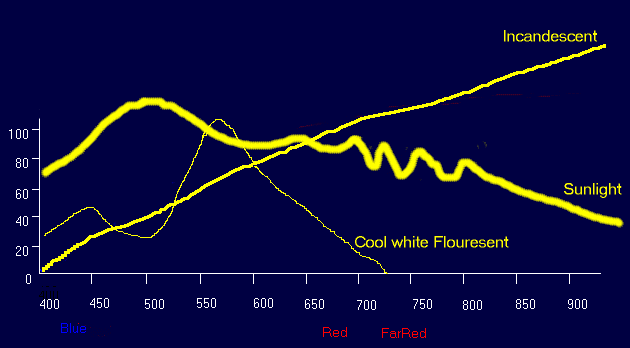 |
Only 37% of the energy in sunlight is within the wavelength (colors) useful for photosynthesis, while 62.4% is infrared (thermal energy) and the remaining 0.6% is ultraviolet. Photosynthesis in the plant leaf is powered by 1% of the sunlight that falls on the plant, 10% of the sunlight is reflected and 10% passes through the leaf. The leaf will retain 80% which is used for transpiration. Some of the light is re-radiated, while the fraction that remains is used for building building food from the carbon dioxide, minerals and water.1
 |
Percentage of usable of light energy (0-100% y-axis) / Light spectrum range (x-axis). For photosynthesis the most important spectrums of the light are blue and red.1 Germination, flowering and stem growth are influenced by red to far red. In artificial environments it is important to keep these factor in mind when programming the light source for the plants life cycle. For the associated light spectrum consult your bulb's manufacturer.
1. The
Solar Greenhouse Book
Chart of Usable Light Energy for Artificial Lighting
Useable light energy for plant
growth is measured in Micro-Einsteins ( micro-mols of photons per meter
squared per second). The sunlight reaching a plant is approximately 2,200
micro-einsteins on a cloud-less day and 170 micro-einsteins
on a cloudy day.
For indoor growing under artificial lighting a range of 395 to 500 micro-einsteins is considered by experts to be minimal for plant growth. Note: The higher the bulb wattage the further away the plant must be from the light source to prevent the plant from transpiring too quickly. Thus, the further the plant is from the light source the less available useable energy is delivered to the plant. For optimum usable energy, select a bulb that has the lowest wattage with the highest usable energy coefficient.
Here is chart that can help
you in determining the useable light energy for your plants.
| BULB Type: | Distance: | Micro-Einsteins: | Usable Energy Coeffecient
(micro-einsteins per watt) |
| Incandescent
100 watt |
3 inches | 310 | 3.100 |
| Incandescent
100 watt |
6 inches | 190 | 1.900 |
| Incandescent
100 watt |
12 inches | 65 | 0.650 |
| Incandescent
100 watt |
18 inches | 27 | 0.270 |
| Incandescent
100 watt |
24 inches | 18 | 0.180 |
| Incandescent
100 watt |
36 inches | 9 | 0.090 |
| Halogen
20 watt |
3 inches | 1279 | 63.950 |
| Halogen
20 watt |
6 inches | 413 | 20.650 |
| Halogen
20 watt |
12 inches | 145 | 7.250 |
| Halogen
20 watt |
18 inches | 122 | 6.100 |
| Halogen
20 watt |
24 inches | 65 | 3.250 |
| Halogen
20 watt |
36 inches | 32 | 1.600 |
| Sodium
250 watt |
3 inches | 250 | 1.000 |
| Sodium
250 watt |
6 inches | 99 | 0.396 |
| Sodium
250 watt |
12 inches | 30 | 0.120 |
| Sodium
250 watt |
18 inches | 14 | 0.056 |
| Sodium
250 watt |
24 inches | 10 | 0.040 |
| Sodium
250 watt |
36 inches | 7 | 0.028 |
| Gro-Lite
100 watt |
3 inches | 420 | 8.400 |
| Gro-Lite
100 watt |
6 inches | 135 | 2.700 |
| Gro-Lite
100 watt |
12 inches | 60 | 1.200 |
| Gro-Lite
100 watt |
18 inches | 31 | 0.620 |
| Gro-Lite
100 watt |
24 inches | 18 | 0.360 |
| Gro-Lite
100 watt |
36 inches | 9 | 0.180 |
| Fluorescent
40 watt |
3 inches | 52 | 1.300 |
| Fluorescent
40 watt |
6 inches | 36 | 0.900 |
| Fluorescent
40 watt |
12 inches | 13 | 0.325 |
| Fluorescent
40 watt |
18 inches | 7 | 0.175 |
| Fluorescent
40 watt |
24 inches | 5 | 0.125 |
| Fluorescent
40 watt |
36 inches | 2.5 | 0.063 |